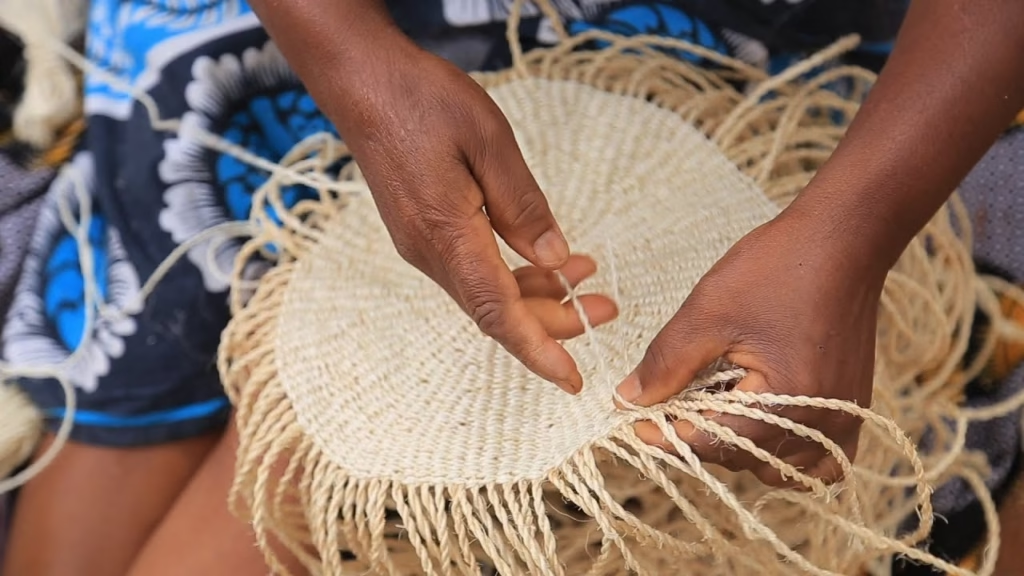
Under the shade of sunlight sieving makuti shades, Mrs Evelyn Mghoi, her face, the map of weathered knowing, meticulously twists strands of fibrous sisal. Her hands move strongly with the grace of an artist, bringing to life the intricate patterns that define Taita’s renowned sisal baskets. Each weave carries memory, and each weaver tells a story of their own.
At the age of 76, Mrs Mghoi is more than just a basketry artisan; she represents the scribe of the passages of a scripture closing up on the precipice of oblivion. She is one of the few remaining experts in weaving passed down through her matriarchal lineage for decades. “My mother taught me to weave baskets when I was young,” she recalls, her voice soft and with confidence.” Now I am one of the few remaining women who still uphold this craft.”
Traditionally, these baskets were used for carrying harvest, storing grain, and other commodities. They define tangible links to the Taita’s cultural identity, each turn of the sisal fibres tells about the ancestral techniques and communal heritage. The preparation alone is a testimony of dedication. After harvesting, the sisal is soaked and then tightly scraped to obtain the tough fibers, which are then sun-dried. This has already been done; the fibers are rolled into strong threads ready for weaving.
The future of this beautiful tradition, however, is as fragile as a single strand of sisal. The once very cherished tradition is slowly unraveling, primarily because of the changing world. Modern times have seen young women move to urban centers in pursuit of quicker and more lucrative jobs. Younger women have viewed this practice as one with arduous labour and low returns. The allure of factory work, hawking in bustling markets, or even boda boda riding outweighs the hours spent in preparing fibers and weaving baskets.
“My daughters and granddaughters have left. The cities beckon with fast money and quick living,” Mghoi says, her voice a papery hush. They see the effort but not the spirit of it. They do not want to spend days scrapping sisal for fibres; they want to move fast and large. Indeed, the process requires patience and knowledge that fewer and fewer possess.
Further heightening the challenge, the iconic sisal scarves once worn with pride have been largely displaced with disposable cheaper, mass-produced plastic imports. This shift has massively disrupted the market for weavers, leaving them few avenues where they can sell the creations of their intensive labor.
However, a glimmer of hope still exists courtesy of collectives such as Kanjado Weavers Women Group in Mwatunge. Currently composed of elderly women like Mrs Evelyn Mghoi, this cooperative is a hub of shared knowledge and mutual support. Here, the whirring of each conversation blends with the rhythmic sounds of weaving, each collectively working to keep the tradition alive.
Gladys Mshai, a spirited and core member of Kanjado Weavers, understands the urgent need to keep this tradition alive on to the generation to come. “This is not all about money, though it helps us meet our daily needs,” she explains, perfectly demonstrating how to perform a symmetrical stitch. “It’s about who we are. If we lose our basket, we lose our history, an outstanding element of our culture.”
Despite various challenges they face today with modernization in place, Kanjado weavers too are adapting to the changing Recognizing the rapid changes in market trends, they have transformed the humble sisal basket into a more elegant exportable product. Their practice now includes stylish handbags adorned with leather accents, intricate lampshades, and decorative wall hangings that tell the story of the sisal. These modern interpretations are finding appreciable buyers both locally and internationally from tourists and people living abroad, providing a pivotal lifeline for these artisans.
Yet the bigger question remains, who will carry the torch of sisal basketry to the future and prevent the wind from blowing it off when Mrs Mghoi and the others can no longer weave? The challenge is to bridge the generational gap to enable the youth to appreciate the richness and sustainability of the livelihood that sisal weaving can offer. New efforts have been geared towards creating more attractive incentives for younger generations to learn the craft.
As the sun dips below the Taita hills, painting the shadows of Mrs Mghoi’s weathered hands, the sheer beauty of the sisal basket tells its own powerful story.
It vividly symbolizes the resilience, pride, and unwavering resolve of women like her who simply have refused to let their culture fade away. While fewer weavers exist now, the enduring spirit of Taita’s sisal weavers still shines brighter, intricately woven into every single pattern, one basket at a time.

